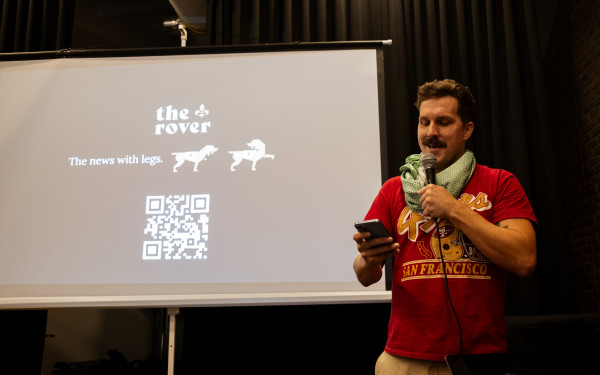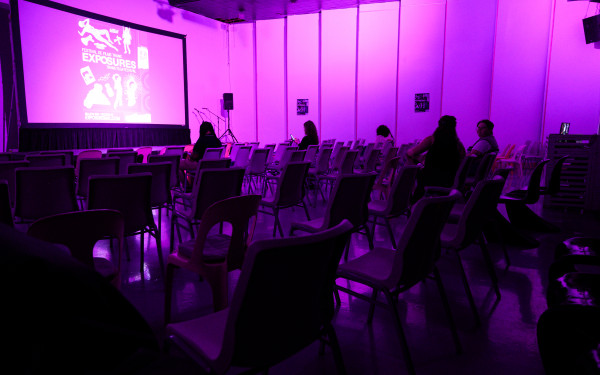Artist Panel Explores Mobility and More
Answering the Questions We’re Too Afraid to Ask
Montreal is over.
Many artists are left with this thought when their time as undergrads has finished. You might be at the end of your rope. Pining for a secure job doing what you love; your vision doesn’t include waiting tables or bagging groceries, but you need some sort of income to keep creating.
The prospect of gathering your belongings and booking a ticket to Berlin or to the city where your parents live suddenly looks inviting—and waiting for the drought to end looks ridiculous.
Just before the onset of reading week on Feb. 16, Art Matters and the English-Language Arts Network presented a panel called, Where to Now?
Through this platform, writers, choreographers and multi-disciplinary artists based in Montreal offered their insight and advice on how to move forward as an artist beset with doubt.
“Many people cut their teeth making art here, whether at an institution like Concordia or on their own terms,” said Amy Macdonald, the panel moderator. “We wanted to bring together artists who represent very different approaches and experiences, who had travelled with their artistic practice.”
But the question of whether to take root or disperse is tied to many factors, which vary for everyone. Ideas about ethnicity, socioeconomic status, language barriers, and community were at the crux of their advice.
Concerning flight, as one educator and poet, Malek Yalaoui pointed out, “mobility is a privilege.” The freedom to move is not always a solution when you and your practice are stunted, she explained.
“Who can afford to move and resettle?” she asked.
While Europe may seem like the land of milk and honey, it’s important to consider that not everyone has the same options.
“Who can move through borders easily and who cannot?” Yalaoui continued. In light of political gestures south of the border, impediments to mobility are very real for some people.
With the subject of community inherently embedded in the panel, what can be gathered from this is the important realization that you can work with your surroundings—your immediate community.
But while the people surrounding you could be a solution to that inevitable financial or creative block, “community” is a concept that is open to interpretation.
While it can symbolize both belonging and isolation, some of the panelists recognized community to be synonymous with networking—establishing strong relationships with those in your field, where you reside and abroad.
Choreographer and dancer, Emily Gualtieri, observed that collaboration can “mitigate the risk of writer’s block,” something that all artists will eventually face.
“Trust is huge.“— Chloë Lum, artist
For Gualtieri, producing dance art through collaboration enabled her to actually “share it,” she said. Integrating the interpretation of others better prepared her work for the audience, she explained.
Nonetheless, other speakers admitted that community can often translate to expectations without support; art production with no sense of personhood.
“Community can bleed you dry,” said Yalaoui. In the event that people choose to manipulate you, she said, “a word to the wise: refuse.”
One audience member, who chose to remain anonymous, raised the issue of abuses of power in creative industries. Positions within the arts may be coveted, but employers—or technically supervisors for unpaid positions—can abuse their status.
Half of the panelists attested to the challenges of living and creating under the weight of mental illness—power dynamics can exacerbate such conditions.
In collaborative work, “trust is huge,” said Chloë Lum, a multidisciplinary artist who has worked with her artistic counterpart, Yannick Deslanreau, for years.
Gualtieri, Lum, and Yalaoui all agreed that when your integrity as an artist and person is disregarded, such a partnership is not worth pursuing.
“You should never dehumanized yourself,” said Yalaoui.
Gualtieri described a similar standard—the necessity of open communication between yourself and your creative partner to ensure equal representation, and equal credit. You have to be clear about what collaboration will provide for both parties, she explained.
In the event that you cannot escape your geographical reality, the online world is an accessible route.
Lum described doing “a lot of distance work” at the onset of her career. When your field is small, reaching out physically may not be possible, at first. The internet provides an easy entry point to more diverse opportunities.
It is important to remember that you may have to build the space you need.
Yalaoui uses her voice to create platforms for women of colour. Her intent was to reframe the “rigged game” experienced in spoken word; in other words, one that favours the voices of white artists, therefore overlooking and marginalizing artists of colour. In this respect, women of colour who display their work through her platforms are “seen on their own terms.”
Gualtieri’s company, Parts+Labour_Dance, emphasizes co-ownership in performances. It also showcases older dancers, who have difficulty finding employment through other companies. Gualtieri still has to move between Toronto and Montreal to maintain her projects, however.
As in the case of Gualtieri, Lum and Deslanreau, geographic expansion was a must. They can “work by their own politics” by moving where they need to. Desranleau works in Montreal, maintaining a connection here. Lum, likewise, studies in Toronto. Effectively, they are connected to both cities.
For incoming artists, the English-Language Arts Network encourages them to get involved in their community by reaching out, attending events, and building support networks, explained Macdonald.
“It’s really helpful to have people behind you who are ready to engage with your work honestly, help you improve it, and exchange their own energy and knowledge with yours.”

1_900_507_90.jpg)
_600_832_s.png)


_600_375_90_s_c1.JPG)

